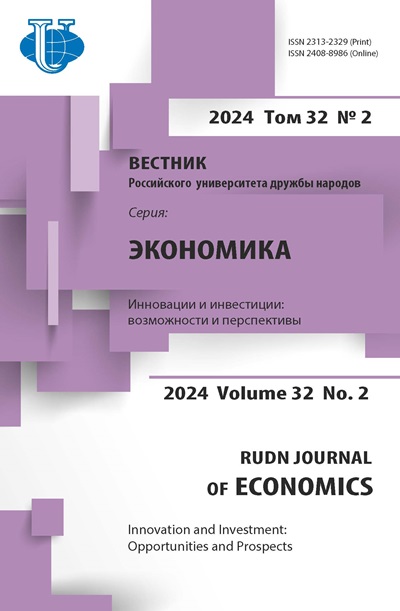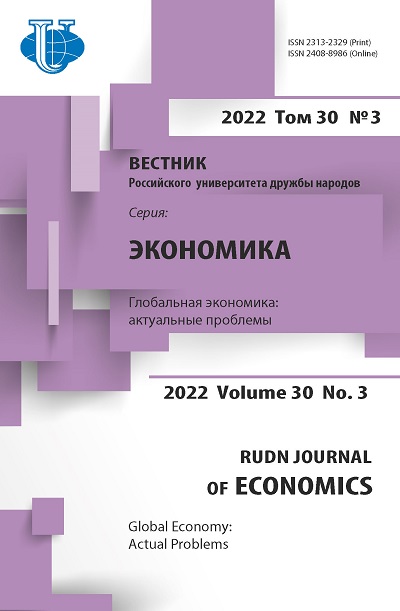Трансграничная торговля энергоресурсами: особенности региона Центральной Азии
- Авторы: Корнеев К.А.1, Печищева Л.А.2
-
Учреждения:
- Институт Китая и современной Азии Российской академии наук (ИКСА РАН)
- Российский государственный гуманитарный университет
- Выпуск: Том 30, № 3 (2022): Глобальная экономика: актуальные проблемы
- Страницы: 343-357
- Раздел: МЕЖДУНАРОДНАЯ ТОРГОВЛЯ
- URL: https://journals.rudn.ru/economics/article/view/32148
- DOI: https://doi.org/10.22363/2313-2329-2022-30-3-343-357
Цитировать
Полный текст
Аннотация
Исследованы роль и место региона Центральной Азии в трансграничной торговле энергоресурсами на современном этапе. С одной стороны, в Азии есть две страны, которые входят в список крупнейших мировых импортеров энергоресурсов, - Индия и Китай. С другой стороны, страны Центральной Азии (за исключением Кыргызстана и Таджикистана) и Россия являются чистыми экспортерами энергоносителей, при этом данный вид экспорта крайне важен для их макроэкономической устойчивости. Неудивительно, что проблемы организации взаимовыгодной торговли энергоресурсами во всем Центральноазиатском регионе являются одними из наиболее актуальных вопросов повестки дня всех заинтересованных сторон. Итак, в центре внимания находится анализ и оценка энергетической составляющей сотрудничества между Россией, государствами Центральной Азии, Китаем и Индией. Конечно, Индия напрямую не интегрирована в энергетическую архитектуру центральноазиатского пространства, но ее большой внутренний рынок является одним из факторов роста поставок энергоносителей. Поэтому целесообразно рассматривать Индию как внешнего субъекта, оказывающего значительное влияние на происходящие процессы. Нынешняя практика многостороннего участия в формировании энергетического диалога также может иметь большое значение в геополитическом контексте - как фактор либо дополнительной сплоченности, либо усиления противоречий в рассматриваемом регионе.
Об авторах
Константин Анатольевич Корнеев
Институт Китая и современной Азии Российской академии наук (ИКСА РАН)
Автор, ответственный за переписку.
Email: korneev@ifes-ras.ru
ORCID iD: 0000-0003-3930-6309
кандидат исторических наук, старший научный сотрудник
Российская Федерация, 117997, Москва, Нахимовский проспект, д. 32Людмила Александровна Печищева
Российский государственный гуманитарный университет
Email: mayflower-85@inbox.ru
кандидат исторических наук, доцент, факультет международных отношений, политологии и зарубежного регионоведения, Историко-архивный институт Российская Федерация, 125993, Москва, Миусская площадь, д. 6
Список литературы
- Alifirova, E. (April 2016). Gazprom Resumed Gas Purchases in Turkmenistan. Neftegaz.ru. (In Russ.) Retrieved April 6, 2022, from https://neftegaz.ru/news/transport-and-storage/442490uregulirovano-gazprom-vozobnovil-zakupku-gaza-v-turkmenistane/
- BP (2020). BP Statistical Review of World Energy. Retrieved April 8, 2022, from https://www.bp.com/content/dam/bp/business-sites/en/global/corporate/pdfs/energy-economics/statistical-review/bp-stats-review-2020-full-report.pdf
- Chauhan, P. (July 2019). Cooperation against Competition: India and China in the Energy Sector. South Asian Voices. Retrieved April 15, 2022, from https://southasianvoices.org/cooperationagainst-competition-india-china-energy-sector/
- China Energy Consumption (2020). CEIC data. Retrieved April 11, 2022, from https://www.ceicdata.com/en/china/energy-consumption
- China Power System Transformation (2019). International Energy Agency Technology Report. Retrieved April 14, 2022, from https://www.iea.org/reports/china-power-systemtransformation
- Chow, E., & Hendrix, L. (2010). Central Asia’s Pipelines: Field of Dreams and Reality. The National Bureau of Asian Research Special Report, 23, 1-42.
- Gas 2020. Analyzing the Impact of the COVID-19 Pandemic on Global Natural Gas Markets (2020). International Energy Agency Fuel Report. Retrieved April 18, 2022, from https://www.iea.org/reports/gas-2020/2019-cool-down
- Gazprom Project Data (2021). Power of Siberia Gas Pipeline. The Largest Gas Transportation System in the East of Russia. Retrieved April 19, 2022, from https://www.gazprom.ru/projects/power-of-siberia/
- India Energy Outlook 2021 (2021). International Energy Agency Flagship Report. Retrieved April 20, 2022, from https://www.iea.org/reports/india-energy-outlook-2021
- Mitrova, T., & Yermakov, V. (2019). Russia’s Energy Strategy 2035: Struggling to Remain Relevant. Paris: French Institute of International Relations Publication, 40 p.
- Ralph, W. (2014). China’s New Energy Geopolitics: The Shanghai Cooperation Organization and Central Asia. The German Journal on Contemporary Asia, 133, 24-51. http://hdl.handle.net/10419/109043
- Renewable Energy Industry in India (2021). India Brand Equity Foundation Data. Retrieved April 20, 2022, from https://www.ibef.org/industry/renewable-energy.aspx
- Scalamera, M. (2020). The 2020 Oil Price Dive in a Carbon-Constrained Era: Strategies for Energy Exporters in Central Asia. International Affairs, 96(6), 1623-1642. https://doi.org/10.1093/ia/iiaa164
- Schepers, N. (2019). Russia’s Nuclear Energy Exports: Status, Prospects and Implications. NonProliferation and Disarmament Papers, 61, 1-15.
- The Energy Sector of the Republic of Tajikistan (2019). Ministry of Foreign Affairs of the Republic of Tajikistan. Retrieved April 23, 2022, from https://mfa.tj/en/main/view/185/the-energysector-of-the-republic-of-tajikistan
- The ESPO (Eastern Siberia Pacific Ocean) Oil Pipeline. (2020). Hydrocarbons Technology. Retrieved April 25, 2022, from https://www.hydrocarbons-technology.com/projects/espopipeline/
- The Shanghai Cooperation Organization Official Data (2021). Retrieved April 26, 2022, from http://eng.sectsco.org/docs/about/faq.html















